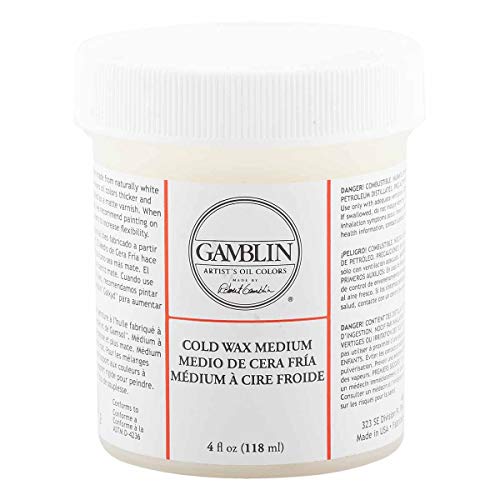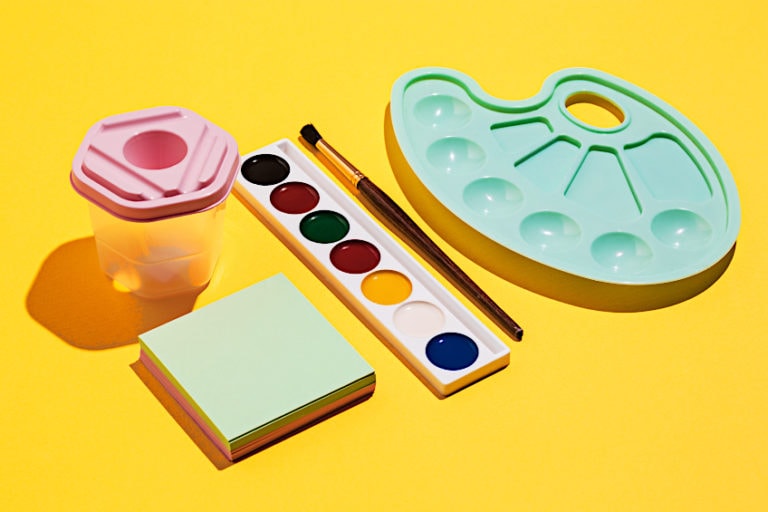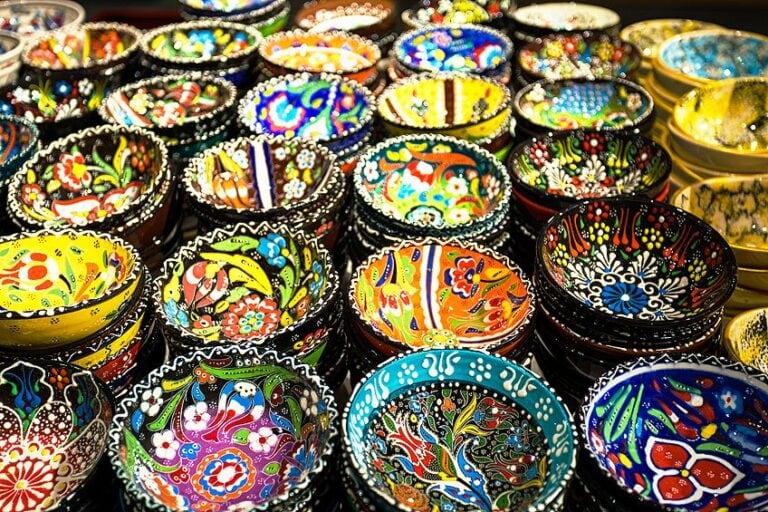Oil Painting Mediums – Finding the Best Medium for Oil Painting
This post may contain affiliate links. We may earn a small commission from purchases made through them, at no additional cost to you.
Oil paint mediums are thought to be quite mysterious, as they can cause uncertainty and confusion when it comes to their properties and uses. The majority of artists tend not to use mediums when they first start out, but with time they get more confident and learn to understand mediums, and will use them all the time. The following article will hopefully equip you with a better understanding of oil paint mediums, which are best to use for your desired results, and where you can use them.
Table of Contents
What Is a Paint Medium?
By using an oil medium with your paints, you will alter the performance of your paint. The oil medium comes in a liquid form and will have been formulated to change the oil paint’s transparency, drying time, viscosity, or even to allow the paint to go further.
Each medium offers different results. For example, one medium can decrease the time needed for the paint to dry, while another medium can speed up the time. Oil paints already have a medium in their formulation, as paint pigment is just dried colored powder that has had oil added to it, which causes the pigment to bind together.
When you incorporate an oil paint medium, you allow yourself more control over the paint. This allows you to add diversity to your textures, patterns, marks, and lines, and overall expanding the painting techniques available to you.
An oil medium is made up of a mixture of several ingredients such as solvents, resins, oils, or drying agents. You can use just one medium with your paint or your can combine several mediums to alter your paint’s performance. By having a good understanding of what you can achieve with each medium, you can then select the correct one for your project.

Changing the Viscosity of Your Oil Paints
You will alter the characteristics of the paint by adding a painting medium to it, and often such a medium will affect the viscosity or consistency of your paint. Thus, if you have thick paint (which the majority of oil paints are), and you add the relevant medium, you can either thin out the paint or make it thicker still.
Increase Flow
If you wish to create finer details with your paint, then you can simply add a medium that makes the paint thinner and reduces its viscosity, allowing your paint to flow with ease. As a result, you will be able to manage the flow of the paint more easily. In doing so, you will be able to create flat, brushless sections as your paint levels itself out,’ and it will also allow your paint to then go further.
Increase Body
As an alternative, you may be looking to have your brush marks stay, giving you a thick paint texture (called impasto), in which case you would then need to thicken your oil paints. You can achieve this by adding a wax or gel medium to your oil paints, which will allow you to achieve sharp, defined knife edges/ridges. In doing so, you will have thickened the paint enough that you can use a painting knife to apply it to your canvas.

Changing the Transparency of Your Oil Paints
Regardless of which type of medium you use, it will have an impact on the surface finish of your piece. Oil paint is made up of oil, filler, pigments, and often drier. If you add anything more to the standard oil paint, however, you will, of course, alter how the paint looks when it dries.
By adding a medium, you can create a range of high-gloss finishes, satin sheens, or even a matte finish.
A medium that contains wax will give you a matte or satin finish, as the wax is considered a matting agent. If you hope to achieve a high-gloss finish, you can turn to a natural resin (while a synthetic resin will give you a soft, satin finish or create a low glow).
It is important to remember that if you are looking to change the viscosity of your paint, you will naturally also alter the surface finish slightly. The same can be said for if you change the transparency of the paint – you will impact the viscosity of the paint somewhat. The two properties are linked and what you do to the one will naturally impact the other.
For interest’s sake, if you are using a medium that changes the viscosity of your paint, and you end up disliking the resulting surface, you can at a later stage take some varnish and fix the issue. You can use varnish to create either more or less gloss on the final surface of your piece. This particular varnish is called picture varnish and you can buy it in either gloss, sheen, or matte. When added to your paint, it produces an assortment of satin finishes.
Painting Mediums That Alter the Drying Time of Your Paints
Different paint manufacturers use different formulations, each giving its own drying time. Each color of paint has its own unique drying time due to the volume of oil and pigment differing in each type of paint. You can alter the drying time by incorporating mediums that can either lengthen (for as long as several months) or shorten the drying time (to just a few hours). While either type of medium can be purchased online or in-store, there is also always the option of making your own fat or lean medium yourself.

Use Fat Oil Mediums for a Slower Drying Time
If the medium contains a large quantity of oil, it will take longer to dry, which in turn offers you more control over your paint. These are known as “fat mediums”. This is particularly effective if you are painting in layers, as using the fat medium in your middle and last layers and will give depth to your color.
The fat medium tends to expand as it dries, so we do not recommend painting over a fat medium with a lea (quick-drying) medium, as this will cause thinner layers that have already hardened to fall apart, resulting in cracks in your paint.
Use Lean Mediums for Faster Drying Times
Quick-drying or lean mediums are amazing if you want your paint to dry quickly. To make this possible, lean mediums are normally added to the paint in conjunction with a lot of resin and solvents that have low levels of oil. Depending on what your mixing ratio is, the ingredients you use, and the type of application you use, your paint can end up drying to the touch overnight thanks to this lean medium. You can add some siccative medium as well to further increase the drying time, but this is all up to you.
What Painting Medium Should You Use?
The use of mediums can alter the drying time, the finish, and the consistency of the paint. You can combine the medium with your paint on your palette, or you can simply dip your paintbrush into the medium before using the paint.
Depending on what you are looking to achieve with your artwork will determine what paint medium you should use. Are you looking to change your surface’s appearance, to decrease or increase your drying time, or perhaps you are looking to thicken or thin your paint? When you have decided, you can then select the paint medium that will provide your desired results
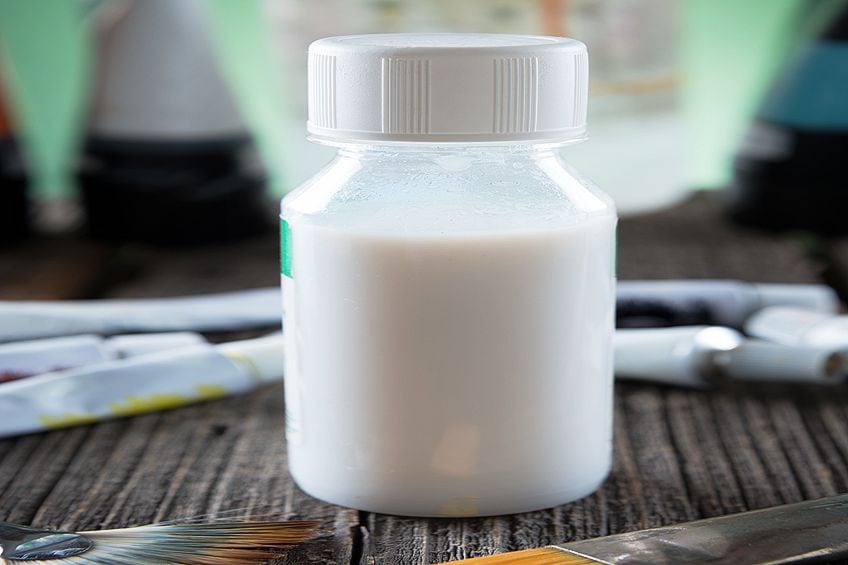
We will now go into more details about the different paint mediums available and how they can impact your art piece.
Oil Mediums for Paint
An oil medium is able to increase the transparency and flow of the paint, slow down the drying time, and level out your brush strokes. However, you cannot mix every type of oil with your oil paints! Only certain oils can be combined with paints, and these include linseed oil and all its variations, as well as safflower oil, poppy seed oil, and walnut oil. These oils are all referred to as drying oils, where other, less-popular oils include soybean, tung, and perilla oils. Soybean and tung oils do not offer an absorbent paint film, and perilla oil tends to yellow when dry.
Refined Linseed Oil
This oil is made from the dried-out seeds of the flax plant and is sometimes referred to as flax or flaxseed oil. This oil is usually used to make paint mediums as it provides great durability in comparison to other drying oils. Refined linseed oil is particularly great for:
- Increasing gloss
- Reducing viscosity
- Lengthening drying time
Refined linseed oil dries at a slow pace and has a low viscosity. The oil is slightly yellow and it may cause the paint to start yellowing over time. The oil is ideal for oil paints as it contains small amounts of linolenic acid and linoleic. Sadly, it is the linolenic acid that will cause the paint to yellow, although it does cause the paint film to be exceptionally strong and durable.

Our Recommendation: WINSOR & NEWTON Refined Linseed Oil
Of all their oils, this is the brand’s most popular. It can be used by both beginners and professionals and comes with amazing reviews. You can add it to your oil paints to slow down the drying time, although it will still take time to dry completely. The oil is alkali-refined and has a low viscosity, meaning that it will thin your paint a little. This medium will heighten the gloss and transparency of your paints, although it will also decrease the color consistency.
- Refined linseed oil is the most commonly used oil by artists
- Slows the drying time of oil paints and reduces color consistency
- Comes in a 75-ml bottle and increases gloss and transparency
PROS
- Easy to use with low viscosity
- Increases the transparency and gloss
- Used by the majority of artists
CONS
- Reduces paint’s color consistency
- Cap can be tricky to take off
Cold-Pressed Linseed Oil
The purest natural oil, cold-pressed linseed oil provides a durable, harder film with an increased gloss finish that is more transparent and also reduces consistency. It takes longer to dry than refined linseed oil so will take roughly four days to be dry to the touch. As a high-quality oil and thanks to its high acid number, it is used as a binder in the manufacturing of paints.
Our Recommendation: WINSOR & NEWTON Cold-pressed Linseed Oil
This cold-pressed oil by Winsor and Newton is a popular option on Amazon. This oil increases gloss and transparency while improving the flow of the paint by reducing its consistency. You can use this oil to grind your pigments and it will also assist in decreasing the number of visible brushstrokes.
- A slightly yellow oil that will improve flow, gloss, and transparency
- Reduces consistency and is ideal for grinding pigments
- Dries slightly quicker than refined linseed oil
PROS
- Increases gloss and transparency
- Improves the flow of the paint
- Decreases number of visible brushstrokes
CONS
- Lid is difficult to open
Linseed Stand Oil
While this oil is a lot thicker than refined linseed oil, it is in other ways very much like linseed oil – for starters, it is also made from flax. The main difference between stand oil and refined linseed oil is the treatment method.
Refined linseed oil is exposed to high temperatures, normally while in a sealed chamber, while stand oil is created by heating linseed oil at a very high temperature for a long period. This heating forms thicker oil by causing the polymerization of the molecular structure, forming a substance with the consistency of honey, meaning that it goes a lot further than the likes of refined linseed oil.
Stand oil is perfect for glazing, as it gives a stunning glossy finish. Thanks to the reduction in its oxidation, this oil is not prone to yellowing.
This oil provides amazing brush leveling, but refined linseed oil flows better, which can result in your paintbrush dragging. Stand oil is also less likely to allow the upper layer of paint to be taken up or absorbed by the lower layer, a phenomenon known as “sinking in”. If you combine your oil with some turpentine, the drying process will then become a lot shorter – even more so than that of refined linseed oil if it was mixed with turpentine.

Our Recommendation: GAMBLIN Aceite Stand Drying Oil
This is an oil with a high viscosity that provides a finish similar to that of enamel. You will slow down the overall drying time of the paint when you add this oil. It will also create an effect of wrinkling, also known as the alligator effect, which is visually stunning.
- Polymerized refined linseed oil made from North American flax seeds
- High viscosity medium that slows down the drying time
- A heat-bodied and heavy oil that leaves an enamel-like finish
PROS
- High viscosity
- Enamel-like finish
- Slows down the drying time
- Creates wrinkling effect
CONS
- May require a diluter when mixing with colors
Safflower Oil
This oil is often used as a binder in the manufacturing of paint as it contains very little linolenic fatty acid (the substances that cause paint to yellow). As a painting medium, this oil has a lower viscosity than that of refined linseed oil, which allows it to flow with ease and spread much further. It is also not as expensive as refined linseed oil and will never really dry completely.
The oil is not durable at all, however, and has a very weak paint film. In fact, many have chosen to avoid using this oil as a medium due to this, as it may even cause the paint to melt in extremely warm temperatures. If you do plan on using this medium, however, use it sparingly and it will work well.
Our Recommendation: GAMBLIN Safflower Oil
Gamblin’s safflower oil is non-yellowing, slow-drying, and a great option if you are looking to thin your oil paints. Lighter in color than linseed oil, this is a great medium to use with white and light-colored paints, as it will show them off and make them shine. The oil can also be used as a solvent-free cleaner for your brushes during painting sessions, and works as a good alternative to mineral spirits.
- Lighter in color than linseed oil, non-yellowing, and slow-drying
- An excellent medium for passages of white and other light colors
- Makes for an excellent solvent-free paintbrush cleaner
PROS
- Non-yellowing
- Slow-drying
- Can be used as a brush cleaner and an alternative to mineral spirits
- Thins oil paints
- Great for enhancing lightly colored paints
CONS
- Transport packaging can be subpar when ordering online
Poppy Seed Oil
As one may guess from the name, poppy seed oil is made from the seeds of a poppy plant. This is an oil that is clear in color and is very similar to safflower oil. Thanks to being clear, it will in no way impact the color of your paint, and there will also be less chance of your paint discoloring over time. In fact, some manufacturers have been able to ensure that their paint colors maintain their sharp hues over time by using poppy seed oil in the paint. The drying time of this oil is slower than that of safflower and linseed, and it will improve the gloss and flow of the paint. The paint film is not very durable as it contains only a little fatty acid, but linseed oil remains softer.
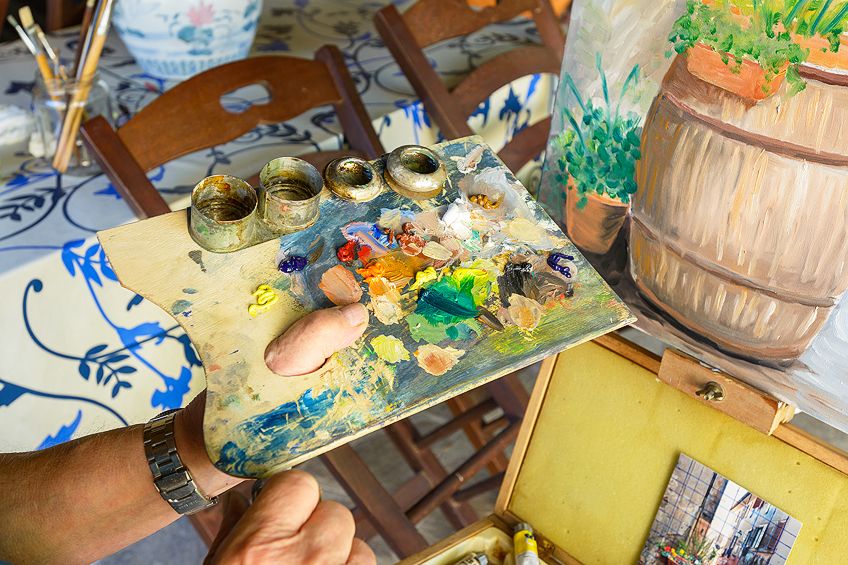
Our Recommendation: Winsor & Newton Drying Poppy Oil
This oil medium by Winsor & Newton is a high-quality medium that accelerates the drying time of oil paints, enhancing their flow and gloss without yellowing. The 75ml (2.5oz) bottle is a convenient size, perfect for artists who need a portable and effective solution for quicker layering and finishing in their projects.
- This oil speeds up the drying process of oil paints, allowing for quicker layering and finishing
- Made with refined poppy oil, it enhances the flow and gloss of oil paints without yellowing over time
- The 75ml (2.5oz) bottle is perfect for artists needing a portable and manageable amount of drying oil for their projects
PROS
- Decreases drying time
- Enhances Flow and Gloss
- Convenient Size
CONS
- Odor
- Yellowing
Walnut Oil
Instead of using linseed oil, you can also use walnut oil as it will provide you with a flexible film and more durability than poppy or safflower oil. The oil provides your color with great depth and is glossy and durable, while also improving the flow of the paint and slowing down the drying time.
If there is an area on your painting where the oil has been absorbed into the bottom layer of paint, you can apply a thin layer of walnut oil, which will rejuvenate the brightness of the color.
To produce walnut oil, the walnuts are cold-pressed and the oil that is released is then refined. The oil is not as durable as linseed oil, but it dries a lot faster than poppy seed oil. You can also combine it with linseed oil to increase its durability. Be careful when storing your walnut oil, as if it is exposed to air, it can become rancid – rather store it in the refrigerator.
Our Recommendation: M. GRAHAM Walnut Oil
This walnut oil increases the paint’s flow and slows down the drying time. This is a non-toxic and solvent-free option that is also non-yellowing, which means that the vibrancy of your paint colors will be maintained. You can also use this oil as a means of removing paint from artist’s brushes without the use of a solvent.
- Removes color from brushes without creating a solvent hazard
- Addition of walnut oil to color will increase flow and slow drying time
- Non-toxic, solvent-free, and non-yellowing to retain color brilliance
PROS
- Slows down the drying time
- Increases the paint’s flow
- Non-toxic
- Solvent-free
- Non-yellowing
- Can be used as a brush cleaner
CONS
- Container has been known to leak
- Can prove difficult to pour
Solvents vs. Paint Mediums
When you have finished painting and need to clean your brushes and equipment, you will require solvents. However, solvents can also be used in your painting process. When used as a painting medium, a solvent has certain properties such as thinning out the paint, increasing the flow of the paint, making the drying time faster, providing a matte finish to your paint, and increasing the paint’s transparency.

The solvent will evaporate from the surface when used in your paints within roughly 24 hours, and this will allow the binder and pigments to oxidize. The surface finish of the paint will also be changed by the solvent, leaving the color brittle, dryer, and duller.
So, rather only use solvents at the beginning of your artwork to thin paints that will then not be seen when the painting is finished.
When using a solvent to thin out your paint, keep in mind that too much solvent can cause your paints to become chalky. If you use your thinned paint over oil-rich paint, it can result in the paint film cracking, to ensure that this does not occur, keep in mind the “fat-over-lean-rule”, which we explained earlier in this article.
If you are new to working with oil paints and you do not know how best to combine the solvents with your paint, start by blocking in colors by using just solvents and pigments. Then, you can move on to a 1:2 oil-to-solvent ratio and then on to 1:1, after which you can then increase the volume of oil in your mixture for each layer.
You should ensure that the oil is added to the solvent and not the solvent to the oil, as the linseed oil is viscous and needs to be agitated before mixing. Allow the medium mixture 48 hours to rest, and ensure that it has combined sufficiently before you use it.
We will now go into a little detail about the solvents you can use in your paint as mediums.
Turpentine
This is commonly known as “turps” and is made from pine tree resin that has been distilled and then evaporates very quickly. Of all the solvents, this one is the most compatible for use with oil paints, and when combined with oils and pigments, you will be left with a stunning, even finish.
You want to ensure that you purchase the refined-grade turpentine, particularly if you plan to use it with artist’s paints. This is because the standard turpentine you find in the hardware store has so many impurities that you can not mix it with your oil paints. If you use a turpentine that has not been distilled, it will have a gum residue in it that can result in your paints turning yellow.
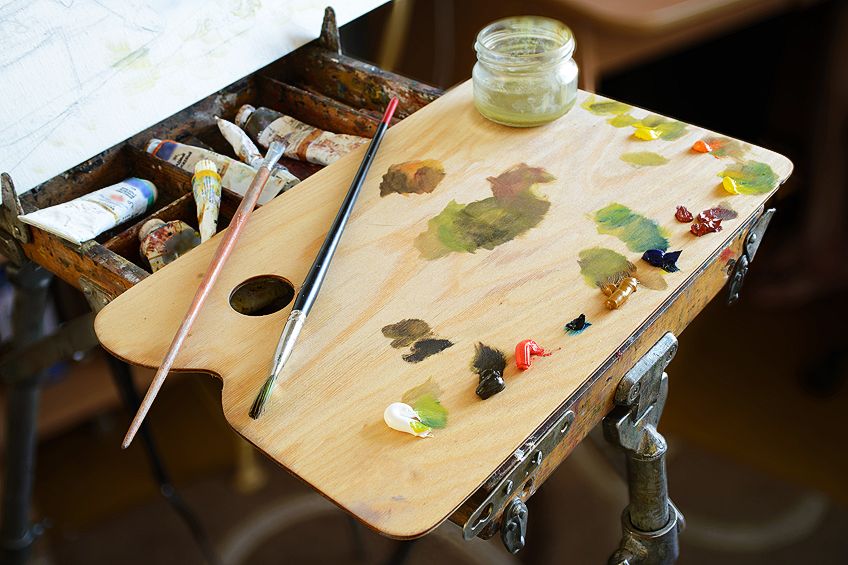
Turpentine gives off a very toxic vapor which, if breathed in, can be harmful to your health. You need to ensure that you are working in a well-ventilated space and that you are wearing the relevant safety gear when working with turpentine. The cap needs to be securely fastened when not in use, and you need to ensure that pets and children are kept away from it. The product can be used over and over again, but just make sure that you have allowed the sediment to settle before using it each time.
If you are hesitant to use turpentine due to its toxicity, there are many other non-toxic solvent options available as well.
Best Turpentine Substitute: WEBER Odorless Turpenoid Artist Paint Thinner and Cleaner
This product has both the same drying time and the same painting properties as those of turpentine all the while being odorless. It can be used with both alkyd and oil colors as a painting medium, and will not affect the color in any way.
- The top odorless, volatile, and thin turpentine substitute
- Has the same painting properties and drying time as turpentine
- Odorless and works with oil and alkyd colors as a painting vehicle
PROS
- Same drying time and painting properties as turpentine
- Odorless
- Can be used with oil paint to thin it out
- Will not affect paint color
CONS
- May not clean brushes effectively
- Pricey
Odorless Mineral Spirits (Artist’s White Spirits)
Distilled from petroleum, mineral spirits can be used to thin your oil paints with great effect. Referred to as odorless mineral spirits in the United States and as artist’s white spirits in the United Kingdom, this is a popular solvent all the world over. It is a lot more abrasive and less compatible with oil paints than turpentine, however, and can break down your paints in uncontrollable ways.
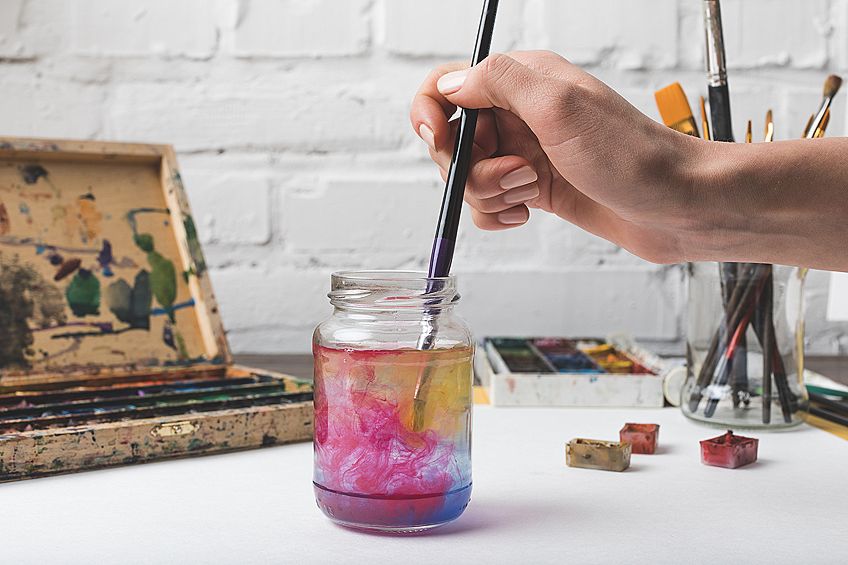
Best Solvent-Based Medium: U.S. ART SUPPLY Odorless Mineral Spirits Thinner
This product is ideal for thinning or diluting your oil and alkyd colors and will not give off an unpleasant odor like turpentine. The formula is highly refined and assists in blending and thinning oil-based paints, stains, and varnishes, and it is also amazing to use in blending colored pencil art.
Thanks to the product being odorless, it can be used both outdoors and indoors and is quite pleasant to work with. It is, however, combustible, so be careful when working with it, and naturally, swallowing it is very bad for your health. This is also an amazing product to use to clean your brushes and equipment, and will leave little to no residue behind.
- A premium, highly refined solvent that effectively thins oil paints
- It blends well and can be used like turpentine with no harsh odor
- Cleans and degreases paintbrushes with minimal residue
PROS
- Cleans equipment and brushes effectively
- No toxic fumes
- Odorless
- Paint is blended with ease
CONS
- Dangerous if digested
- Combustible
Oil of Spike Lavender
Instead of using turpentine, you can also try oil of spike lavender. This natural solvent can break down thicker paints and will mix very well with oils to form a medium, meaning that you will use a lot less when you thin out your paints.
It can also increase the adhesion between the layers of your oil paints and can extend the uniform particle dispersion, all while improving the transparency of your painting. It is nowhere near as toxic as turpentine and, while it does give off some fumes, they are not nearly as bad as turpentine. In fact, many people have even commented that this solvent has a pleasant smell.
Keep in mind that this is still a solvent, which means that you will need to be careful when using it. Ensure that you are working in a well-ventilated area and that you are wearing the correct safety gear.
Our Recommendation: CHELSEA CLASSICAL STUDIO Lavender Spike Oil Essence
This product is a much safer option than turpentine and gives off a much nicer smell. This solvent has been around for a long time, offering a natural means of thinning oil paints since the Renaissance. This product can be combined with other oil paint mediums, resins, and varnishes as well. With a sweet lavender aroma, this essence oil not only thins your oil-based paints, but it can even safely be used in aromatherapy and soap-making!
- A safer, natural alternative to Turpentine with a sweet lavender scent
- A natural solvent that thins oil paint mediums, resins, and varnishes
- Great for use with fine oil colors and even blending colored pencils
PROS
- A safer alternative to turpentine
- Can thin out your paint
- It can dissolve resin and varnish
- Works well in blending colored pencils
- Pleasant lavender scent
CONS
- Lack of a dropper makes it difficult to dispense
Cold Wax as a Paint Medium
Cold wax as a medium can thicken your paints due to its thick, pastey format. It leaves your work with a matte finish, shortens the drying time, and adds more texture to your brushstrokes. When you use cold wax, it is not just a medium, but a whole form of painting referred to as cold wax painting.
You can add luminosity and transparency to your painting through the use of cold wax, and you can add as much wax as you would like.
The advised mixing ratio is 1/3 cold wax with 2/3 oil, which will give you an impasto texture. You can even combine dry pigment with your wax, or choose not to include oil at all. To stop any paint layers from cracking, you will have to add a small amount of alkyd.
It is easy to paint with wax, as the fat-over-lean rule does not apply when it comes to stopping the paint from cracking. The drying time is also sped up. When you combine resin, solvents, beeswax, and linseed oil, you will form a cold wax medium – the soft wax will harden when the solvent evaporates.
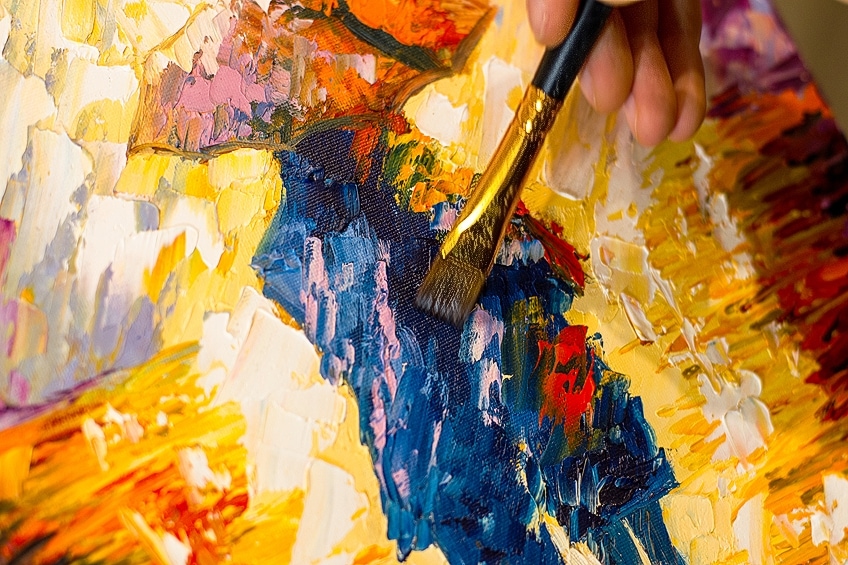
Best Cold Wax Medium: GAMBLIN Cold Wax Oil Painting Medium
This product is made from natural white beeswax mixed with a small portion of dammar resin, forming an encaustic medium. You apply the product to your canvas using a small palette knife, where you will notice the wax adhere to the canvas as if one had broken the stroke. If you want to use a larger palette knife, you can form impasto-textured strokes and sharp points. This wax has a melting point of 155 degrees Fahrenheit (68.3 degrees Celsius), so your paint will not melt even on a hot day.
- Used to make oil colors thicker and matter
- It can be thinned or even applied as a wax varnish
- Add galkyd to cold wax medium to increase sheen and flexibility
PROS
- Can be used to make oil colors matter and thicker
- Has a high melting point, so your paints will not melt
- Can be used as a wax varnish
CONS
- Pricey
Best Beeswax Paste: MICHAEL HARDING Artists Oil Colors Beeswax Paste
Renowned for their premium artist oils and mediums, Michael Harding offers beeswax paste made from a mixture of linseed stand oil and bleached beeswax. This medium will increase the body of your paint, thus lengthening the drying time, which means that you will have plenty of time during which you can work with the paints. Once dry, you will be left with an attractive, satin-matte finish.
- This beeswax paste increases the body of oil colors
- Gives longer working time and produces a satin-matte finish
- A blend of linseed stand oil and pure bleached beeswax
PROS
- Provides a longer working time
- Lengthens drying time
- Produces a satin-matte finish
CONS
- Quite expensive for the amount you get
Alkyd Resin as a Paint Medium
This medium is a synthetic resin originating from oil that will make your paints dry more quickly whilst adding body and a glossy finish. The majority of manufacturers create alkyds by mixing slow-evaoporating mineral spirits (which is odorless) with a plant-based, oil-like soy (which is very polymerized). Alkyds can stretch your paint, allowing it to go further on your canvas – but be careful not to make it too runny or transparent.

Your paint should dry in just a day when you mix an alkyd medium with your paint. So, if you are someone who works quickly and does not want to wait too long for their paints to dry, then we recommend that you include an alkyd medium in your painting process. Alkyds also provide a finish that is glossy, flexible, and firm, resulting in a glass-like surface.
As an alkyd is not an oil, the fat-over-lean rule is not relevant here. An alkyd can either be “fat” or “lean”, but as a standard, an alkyd is thought of as “fat”. This means that you can increase the amount of alkyd you add to your paints in successive layers to increase the flexibility of your paint. You can also thin out your alkyd medium if it is too thick, but you cannot use thinners for this. Instead, use odorless mineral spirits (OMS).
There are several different types of alkyd mediums, and we are going to look at a few.
Walnut Alkyd Medium
This medium originates from walnut oil and has a thickness that can be compared to stand oil. It is a non-toxic and odor-free medium with the following properties:
- 100% solvent-free
- Speeds up your paint’s drying time
- Non-yellowing
- Thins out your color
- Improves adhesion between paint layers
- Improves surface finish
- Increases flexibility
This is the ideal medium for alla prima (wet-on-wet) application or glazing, and is designed to enhance the paint’s color. You can expect a particularly fast drying time when adding this walnut alkyd, and you can also use it with other mediums as well.
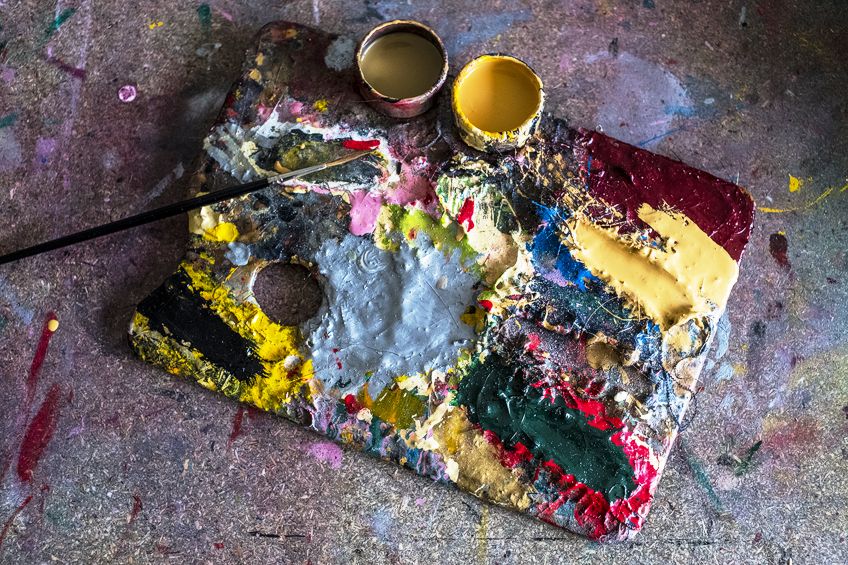
Our Recommendation: M. GRAHAM Walnut Alkyd Medium
This walnut alkyd medium is a non-toxic, environmentally friendly option that you can use instead of solvent-based mediums. The lack of solvents makes for an easy clean-up without the worry about dangerous fumes. A combination of sun-thickened oil and natural resins, this medium type has been a staple in the art industry for quite some time.
This medium has been formulated to increase the adhesion of your paint between layers, thin your colors, and speed up the drying time. It will not yellow your paint and it is perfect for alla prima (wet-on-wet) techniques as well as glazing. The product will improve the surface finish and flexibility while increasing the paint flow, thus allowing you more control over an assortment of painting applications.
- A non-toxic and solvent-free medium that thins color
- Accelerates drying time and enhances adhesion between layers
- Increases surface sheen and flexibility without causing yellowing
PROS
- Better control due to the improved flow
- Environmentally friendly and non-toxic
- Flexibility increased
- Adhesion of the layers of paint improved
- Perfect for glazing application
- Non-yellowing
CONS
- May start to yellow over time
- A bit runny
Liquin Original Alkyd Medium
This is a very fast-drying alkyd medium that will dry to the touch within about six days. The exact drying time will depend on the color as a result of the cobalt drier in its formulation and thickness. You can purchase it in five different thicknesses, each of which has different characteristics. You will have to combine a small portion of the medium to your paint to either thicken it or thin it out, and it will have a transparent finish when it dries.
While this type of product advises that it is resistant to yellowing, some users have reported that they have had yellowing occur over time. It will make your paint tougher once it has been applied, more resistant to cracking, and more flexible. This medium works best without adding any additional drying oils such as stand oil or linseed.
Our Recommendation: WINSOR & NEWTON Liquin Original Medium
This product speeds up the drying time of your paints while also improving the body and flow. It will also decrease the presence of brushstrokes and prevents yellowing. Expect the drying time of your oil paint to decrease by half when you add in this medium, and your piece will become dry to the touch within just six days.
- Speeds up the drying time by half of most conventional oil paints
- Semi-gloss medium that resists yellowing and improves paint flow
- This general-purpose medium also reduces brush stroke retention
PROS
- Halves the drying time of the paint
- Decreases brushstrokes
- Resists yellowing
CONS
- Cannot use it as a final coat or varnish
Galkyd Medium
This medium is very similar to a liquin original alkyd medium as it increases the flow and transparency of the paint while leaving the finish glossy. If you use a decent quantity of the medium, it will ensure that your brushstrokes are leveled out and will offer a durable, enamel-like finish. Thanks to the fast-drying time, you will be able to touch the paint within just 24 hours.

Our Recommendation: GAMBLIN Galkyd Gel
This product assists in creating impasto effects and ensures that your brushstrokes are retained. The medium does dry quickly, but not as fast as other gel mediums. This galkyd gel has a high viscosity and can be applied in several layers.
- A gelled alkyd resin painting medium
- Formulated to hold brush strokes and dry quickly
- Has a high viscosity and can be applied in multiple layers
PROS
- Fast-drying
- High viscosity
- Able to hold brush strokes
CONS
- Does not dry as quickly as other gel mediums
Neo Meglip Alkyd Medium
This medium is seen as a modern-day version of the Flemish Maroger, which is a type of medium that is an all-in-one product. The consistency of the medium is jelly-like and provides a silky, satin gloss and durable finish to your artwork. The gel format contains the body of your paint while also increasing the paint’s transparency and flow. The medium dries at an average rate, which allows you time to work with the paint before it starts to cure.
Our Recommendation: GAMBLIN Neo-Megilp Painting Medium
This medium will decrease the viscosity of your paint whilst increasing its body. Your paint will become more workable thanks to this medium, which will allow you to be able to paint for longer. The medium does not have any odor and will dramatically improve the flow of your paint.
- A soft, silky gel that gives body to paint and decreases viscosity
- This product can be used to produce a luminous Turner-like effect
- Will not darken or brittle, and allows paint to be workable for hours
PROS
- Adds body to your paint
- Paint becomes more workable
- Odorless
CONS
- Decreases the viscosity of your paint
Comparison Chart
All the information we have provided above may seem a little overwhelming so we have put together an easy-to-read table that will help you understand which is the best medium for your requirements.
| Type of Medium | Time Till Paint is Touch Dry | Transparency | Viscosity | Toxicity |
| OIL PAINT MEDIUM | ||||
| Refined Linseed Oil | 3 to 5 days | Glossy finish is heightened; good durability | Low | Non-toxic |
| Cold-pressed Linseed Oil | 4 days | Transparency increased as well as the level of gloss; durable | Average | Non-toxic |
| Linseed Stand Oil | 1 day to 30 hours | Ideal for use for glazing; increases the level of gloss | Very Low | Non-toxic |
| Safflower Oil | 2 to 3 days | Less chance of wrinkling; weaker paint film | Low | Non-toxic |
| Poppy Seed Oil | 5 to 7 days | Increased gloss and smooths the paint, making blending simple | Low | Non-toxic |
| Walnut Oil | 1 to 2 days | Stunning gloss finish; resists cracking and yellowing; and durable | Low | Non-toxic |
| SOLVENT PAINT MEDIUM | ||||
| Turpentine | 24 hours | Used for glazing; is durable and has an even finish | High | Extremely toxic |
| Odorless Mineral Spirits (White Spirits) | 30 hours | Provides an even finish; durable and perfect for glazing | High | Moderately toxic |
| Oil of Spike Lavender | 1 day to 30 hours | Adhesion between paint layers increased; increased transparency | Low | Non-toxic |
| Zest-It | 12 hours to 1 day | Ideal for glazing thanks to it drying clear; flexible film | Low | Non-toxic |
| COLD WAX PAINT MEDIUMS | ||||
| Gamblin Cold Wax | 1 day to 30 hours | Heightened gloss finish; creates textured impasto strokes and sharp points | Creamy | Non-toxic |
| Zest-It Cold Wax | A minimum of 6 days | Heightened gloss finish; creates textured impasto strokes and sharp points | Creamy | Non-toxic |
| Michael Harding Beeswax Paste | 2 days | Provides body to the paint and leaves a matte-satin finish | Creamy | Non-toxic |
| Michael Harding Resin Oil Wax Medium | 2 days | Offers an impasto layers and gives a satin finish | Creamy | Non-toxic |
| ALKYD RESIN PAINT MEDIUM | ||||
| Walnut Alkyd | 1 day | Increased adhesion, surface finish, and flexibility | Low | Non-toxic |
| Liquin Original Alkyd | 1 to 5 days | Does not yellow; durable and very flexible | Average | Non-toxic |
| Galkyd | 1 day | Increased transparency, providing a glossy finish | Low | Non-toxic |
| Neo Meglip Alkyd | 18 hours | Increases flow and transparency; durable; provides a low satin finish | Low | Non-toxic |
When to Use an Oil Paint Medium
As a beginner at oil painting, you may be tempted to use paint mediums a lot as they thin out the paint, thus making it easier to work with. However, the paint thickness may not necessarily be the problem – you might just be using the incorrect brush for the technique you are trying to do. Even if you would like to work with a thinned-out paint (referred to as glaze), the right medium in conjunction with a natural sable brush will ensure stunning results. The right brush is imperative.
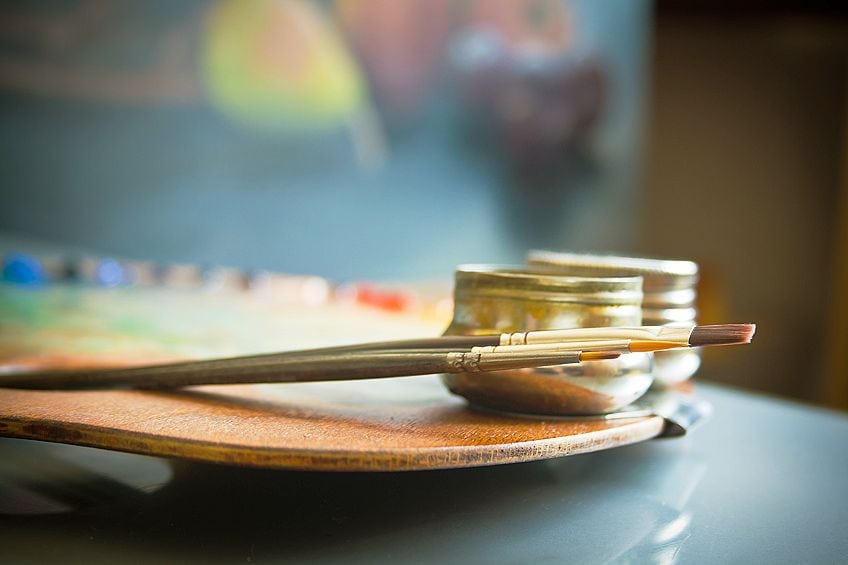
Using a medium is not always the only option, and often, you should only turn to the use of a medium when it is essential and the circumstances call for it. You want to ensure your paint remains vibrant and strong when oil painting, and the solvents present in many mediums will chemically break down your paints, thus decreasing the vibrance of the color.
When you start to decrease the use of mediums in your painting, your colors will become richer and more vibrant. We recommend that you apply thick layers of paint over the thinner initial layers, and then build up the layers, keeping the fat-over-lean rule in mind.
However, once you have gained experience and confidence over time, you can start using oil paint mediums more frequently to increase your painting technique options.
Oil Painting Mediums Recipes
Is it possible to make your own oil paint medium? Yes, it is, and there are many oil painting medium recipes out there. You can create some amazingly useful mediums by following some instructions. Below, we have included recipes for mixing your own slow-drying, fast-drying, and glazing mediums
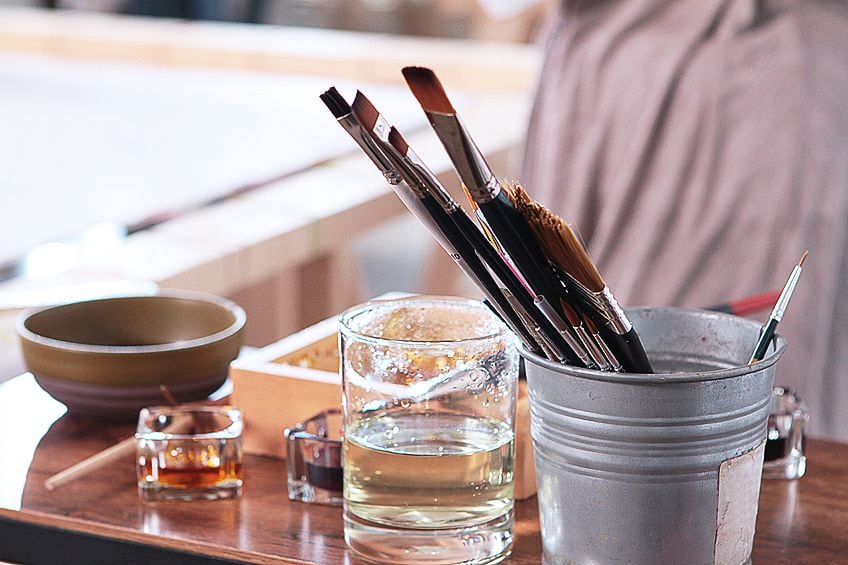
Slow-Drying Medium
This is the easiest medium to make as you only need two ingredients. You just combine the ingredients and then use it as is. The recipe is as follows:
- Mix linseed stand oil and turpentine (odorless mineral spirits) at a ratio of 1:2.
- You need to seal the container and allow the combination to stand – this is necessary as linseed stand oil is pretty thick (similar to honey), and therefore takes a few days to mix properly.
You can also use chestnut oil, poppy seed oil, or walnut oil as a replacement for linseed stand oil.
Alternative Recipe
Take linseed oil or walnut oil and mix it with liquin at a ratio of 1:1. This will create a well-balanced medium with the drying properties of liquin and oil’s ability to improve paint flow. A little goes a long way with this medium, so be careful to only use one drop.
Fast-Drying Medium
You need to take one part oil and combine it with two parts resin, which will create a fast-drying medium (as the solvent will evaporate very quickly). If you choose to add siccative, do not add too much, as it will make the film brittle and dry it out.
Recipe
- 600ml turpentine (or odorless mineral spirits)
- 200ml dammer varnish
- 100ml stand oil
- 90ml cobalt siccative (ensure this is 10% of the overall volume of all the other ingredients)
Glaze Medium
This is as simple as making a slow-drying medium, as you only need three ingredients. The recipe is easy: Simply mix everything together, and you will have your homemade glazing medium. However, be careful when working with toxic materials.
Recipe
Mix 50% odorless mineral spirits (or turpentine) with 40% linseed stand oil and 10% liquins. You are substituting the use of dammer varnish and cobalt drier with the liquin, and you only need half of the solvents that the original recipe requested. This medium’s drying time is 24 hours. To achieve the correct transparency, you can vary the ratio of medium and paint.
Hopefully, this article will be of assistance to you. You may note that several mediums provide the same results but with slight differences. You can use any of these mediums to achieve the similar results in the end. But, if you wish to make a more specific technique, you will require a specific type of medium to provide the desired result.
Frequently Asked Questions
Does One Have to Use an Oil Painting Medium?
While you do not have to use oil painting mediums in your art, many artists feel that the paint you get out of the tube is too thick, so a medium is required to thin it out. You would also require a medium if you are attempting certain techniques, such as glazing.
What Does Fat-Over-Lean Mean?
This just means that you are using a paint that has more oil (fat) on top of a paint layer that has less oil (lean). Start by painting with a thin layer and then building up the layers, with the thicker paint on top of the thin layers of paint until you achieve your desired result.
What Is a Paint Medium?
A painting medium is a liquid that you can combine with your paint to change the performance of the paint in a variety of ways, like its drying time, viscosity, or surface finish.
Larissa Meyer is a 32-year-old mother from Michigan and creative spirit since childhood. Her passion for painting and drawing has led her to an education as an illustrator and a career as a freelance graphic designer. She has a Bachelor of Fine Arts in Illustration and a degree in Graphic Design. Larissa is a talented artist who is able to master a wide range of styles and techniques to bring her artistic vision to life. Her greatest passion is currently fluid painting and epoxy resin art. Larissa’s love for art and her knowledge and experience in illustration make her the perfect Creative Director for our fluid-painting.com team. She is the creative head of our team and shares her passion and knowledge with our community through articles and tutorials.
As a mother of a 2-year-old daughter, Larissa also understands the importance of fostering creativity in early childhood. She uses her experience and knowledge to help other parents inspire their children and develop their artistic skills as well.
Learn more about Larissa Meyer and about us.











